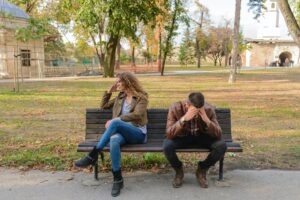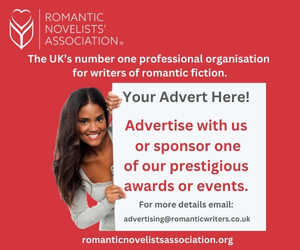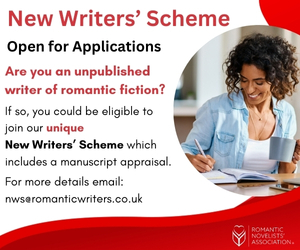RNA 60th Anniversary – How To Write Romance – Conflict/emotion/tension!
17 August 2020
In honour of the RNAs 60th anniversary year, we have put together a special series of blog posts on various aspects of writing romance. These will feature advice and comments from some of our bestselling author members, who all have a wealth of experience and expertise. We hope these posts will be informative and interesting to both new and seasoned writers, but please feel free to add your own tips in the comments section below!
Each month we are highlighting a particular aspect of writing romance, and this month our bestselling authors discuss conflict, emotion and tension, and how best to create it:-

Photo by Ketut Subiyanto from Pexels
Milly Johnson likes building up tension in books. “I like teasing a reader and just when I am nearing a crescendo, I close a chapter and switch to another ‘scene’. I loved the scene in Doctor Foster when the doc is at a dinner table and we all know that she’s going to accuse her host’s daughter of sleeping with her husband, but she draws it out, throws little tidbits into the conversation so her husband starts to get tense because he suspects what’s coming. Masterpiece! And there is always the good old rumour to rely on or hearsay. People wrongly judged but the truth comes out. Your reader should be gagging for the two main characters to get together because you’ve built them up into a literary frenzy.”
“Usually the situations I put my characters in lead to tension and conflict,” says Sheila O’Flanagan, “and it’s the reactions of the characters that inflame them. I suppose it’s the dialogue that will ramp it up.” Elaine Everest agrees – “I find that tension and conflict are best shown through believable dialogue.” Also “stopping a scene at a tense moment and coming back to it further on in the book can really help to ramp up both conflict and tension. Leave the reader guessing, rather like the boof-boof-boof at the end of an episode of Eastenders.”
“I don’t know if I think about creating tension much, I think it just occurs as I go along,“ Katie Fforde muses, while Barbara Erskine feels that “it happens best when plot meets character and the two don’t coincide!”
There are no particular techniques for ramping up tension, according to Prue Leith. “I just write as I feel, and I write the emotions my characters feel. Sweaty palms, breathlessness, feelings of panic and disorientation can all be described with minimum words.”

Photo by Vera Arsic from Pexels
Rosanna Ley doesn’t follow a formula either or planned narrative arc, “but I do try to create lots of questions in readers’ minds. Foreshadowing and atmosphere can help too. It’s important to create lots of barriers for characters to overcome and to try and keep readers guessing. I love clever twists in novels – but it’s not always so easy to pull off successfully! Going backwards helps.”
“Conflict matters,” says Kate Walker, “but not conflict as in sniping and arguing and being nasty. Conflict as in there is something that keeps coming between your characters and driving them away from each other when really they want to be together for the rest of their lives. Something that stops them from being totally relaxed with each other, totally committed to each other, totally in love with each other.” She adds, “Without conflict, you won’t have a story. Your hero and heroine will meet, fall in love, marry and live happily ever after. And that will be that. End of story.”
Do you make sure your hero and heroine have clashing personalities, for example intentionally making them have opposite views on things in order to create conflict between them?
“Sometimes,” Milly Johnson admits, “because it’s nice to see a spark between two people who don’t get on, but they have similar good values which begin to shine through and that is what pulls them together. I never write it so the differences are unsurmountable. But in my latest, the characters are soul mates from the start. It’s the circumstances that pull them apart.”

Photo by Git Stephen Gitau from Pexels
The opposite is true of Barbara Erskine – “Nope. If it happens, it happens, and that is usually good! But one must try and avoid cliché!” Katie Fforde doesn’t either – “I don’t necessarily make sure they have clashing personalities. I always hope they go on to have long and happy marriages but there is always a point when they teeter and we have to think, is this going to work?”
Elaine Everest doesn’t intentionally make her hero and heroine have clashing personalities either, but “no two people are alike and sometimes when opposites attract the sparks can fly. Thinking wrong of a fellow character can throw up problems that need to be overcome before a couple can fall in love. A couple meeting and falling in love is not an interesting story. I like to throw a few bricks at them first.”
Prue Leith says “I usually have them surprised at the attraction of opposites. In The Gardener, the heroine is a historian, cool, quiet, the epitome of good taste, likes white flowers with grey leaves, wants to carefully restore the Georgian garden. The hero is super-rich techno-money, charismatic, likes fibre-glass statues, orange roses and gaudy annuals of Giraffes and wants fountains like Versailles. But, guess what – they end up with love in the potting shed sometimes.”
Regarding opposing views, Kate Walker feels “the most disappointing thing for a reader is the situation known as ‘the big mis-’ – the Big Misunderstanding when the reader feels that all that needs to happen is for the hero and heroine to sit down and have an honest discussion so that everything can be sorted out. It’s the reasons why they won’t/can’t have that talk that twists the conflict and ramps it up.”

Photo by Masha Raymers from Pexels
And she adds, “People worry about internal and external conflict. The best romances are those that have something of both types in them, but the most important element is the internal conflict because the characters must grow and change within themselves in order to achieve true love and to give the reader a satisfying reading experience. An internal conflict is usually a hidden and secret one, so the introduction of an external conflict can force that out into the open. But conflict needs to be about something important – something worth losing the love of your life over. Some of the most intense and heart-wrenching conflicts come about when the hero and heroine love each other, but the circumstances in which they find themselves mean that they cannot admit to that love or act on it.”
And what about backstory/flashbacks?
“Keep them as brief as possible,” is Jill Mansell’s advice, and Liz Fielding agrees. “Feed backstory in in small chunks. If I find myself ‘telling’ in exposition, I remind myself that this stuff would be a whole lot better as part of a conversation between the hero and heroine. Not in a ‘Do you remember …?’ way, but in a ‘What the hell happened …!’ way. As for flashbacks, keep them short!”
Dinah Jefferies feels that “some backstory helps the reader see a character’s motivation, or at least to understand a little about who they are and why they are the way they are. But it’s always tricky. You need enough but not so much you lose the reader. The same goes for flashbacks. A little goes a long way and it depends on the type of book too … generally speaking, I try not to slow down the novel with flashbacks or backstory unless they really help in some way, either to understand the character more fully or to somehow throw light on the main plot. I often find myself cutting backstory during the editing process.”

Photo by cottonbro from Pexels
Barbara Erskine quite often needs them “but they need to be kept under control. Come to think of it, my books are half flashbacks anyway …” And Elaine Everest is not keen on anything that can stop the flow of the main story. “A prologue, or having characters’ chat about themselves, however, can add relevant information in a novel.”
Milly Johnson uses backstory and flashbacks a lot. “As my characters often are formed and shaped by events in the past which are relevant to the story, I consider it an essential.” Prue Leith thinks a flashback is fine “if it’s well done and illuminates the current story. The back story, if it’s necessary, should either be the start of the book, or handled as a flashback. In my trilogy, I put a short backstory before the start of Book One and Book Two, but I’m not sure it was necessary. All the books had to be good standalone novels anyway.”
Sheila O’Flanagan feels the same. “I use both quite a bit in my novels but you have to be careful not to spend too much time in the past because your job as the writer is to move things forward. However, backstory is important in building a rounded character and can explain their motivation for what might otherwise be irrational decisions.”
“Great big chunks of backstory can hold up the narrative progression and slow the pace unnecessarily,” in Rosanna Ley’s opinion. “It’s often essential to include some backstory, however, and these scenes or paragraphs can be inserted at different points in the story, possibly intertwined with current action. Active flashbacks can work well – the length of these may depend on how much information the reader actually needs to know …”
Final word from Kate Walker – “The best way to set up a conflict that works is by becoming deeply involved with your hero and heroine, getting to know them as well as you possibly can, and letting the plot come from them. Lose yourself in their story, write from the heart, and give the novel an emotional edge by making it clear that your hero and heroine have a great deal to lose if their relationship fails. All this will add to the emotional punch of your writing. The deeper the conflict, the more emotional commitment the characters will make to it.”



